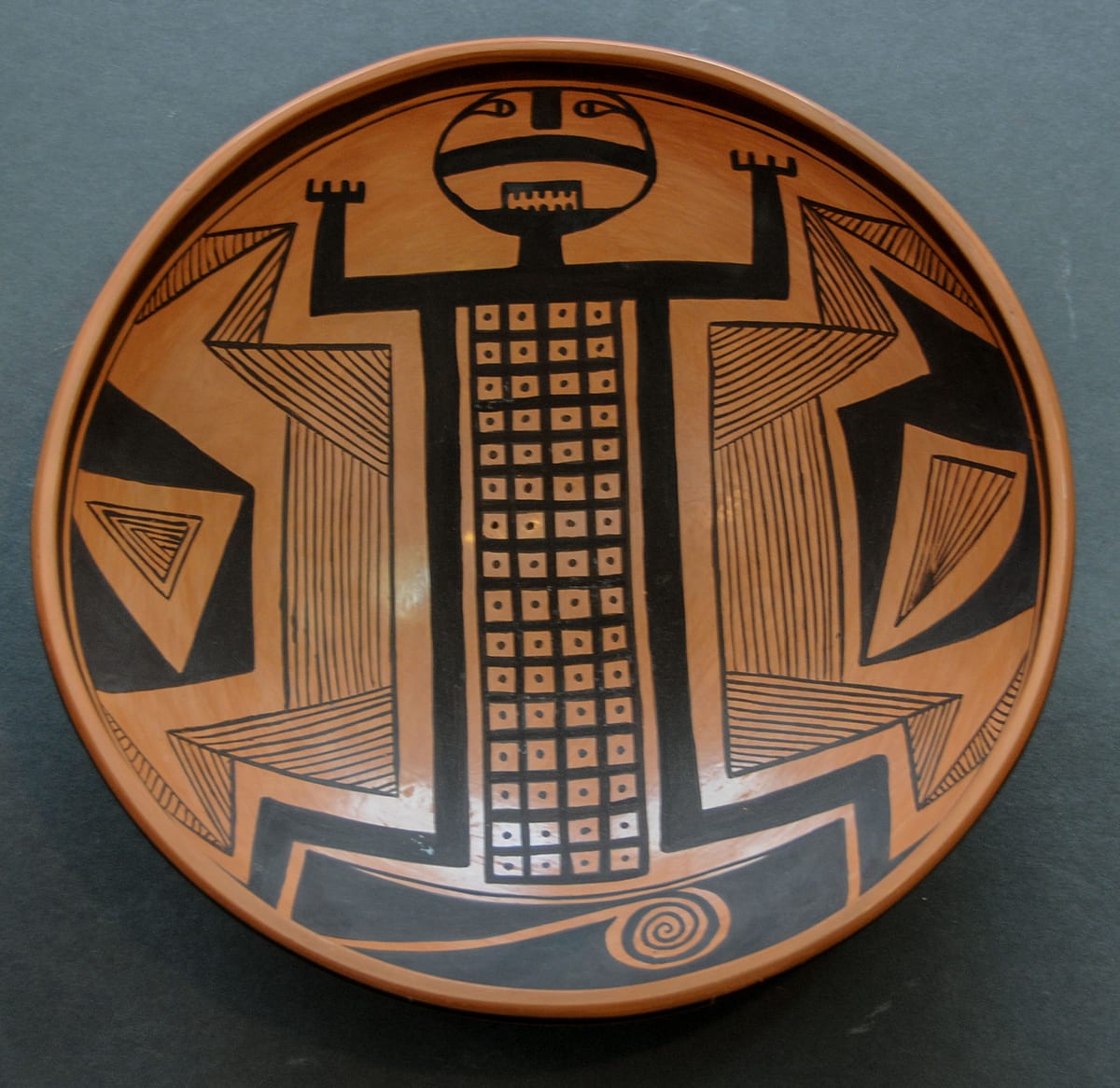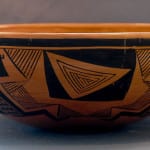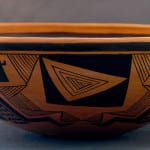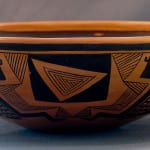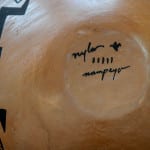Most Hopi and Hopi-Tewa pottery is formed of clay that is grey when unfired and turns light yellow to golden on firing. The term for this material is simply coqa (clay) or masicoqa (dull, lacking color, grey clay) (Wyckoff 1985:151). Sikyatska (or sikacoqa) is a yellow clay found on the Hopi Mesas that turns red after firing. I am told that this clay is particularly difficult to form into a clay body, thus vessels that appear red after firing are usually formed of grey clay and coated with a yellow-fires-red sikyatska slip. Bowl 2012-25, however, was formed from sikyatska clay and is not slipped.
This bowl features a human form as its central design element. The large figure at the center of the interior of the bowl has a crosshatched rectangular body of four columns and 16 rows forming a grid; each square features an imbedded dot. Four similar figures with 3-row by 8-column rectangular bodies grace the outside of the bowl.
Figurative painting is not common on Hopi-Tewa pottery, and so I wondered about the inspiration for this design. Mike McMullen and I visited Nyla in her home on 10/11/13 and I showed her a photograph of 2012-26. She recognized it as a bowl she made “years ago.” She laughed to see it again, and said she got the idea for the design “out of a book,” which she immediately pulled out of a basket of books. Re-Creating The World: Painted Ceramics of the Prehistoric Southwest (text by Barbra Moulard, 2002) displays the pottery collection of Bill Schenck, a well-known painter and was published by him. Plate 49 of the book displays a Salado bowl [1275-1325 CE] with an image Nyla said she adapted for bowl 2012-26. Nyla’s bowl 2012-26 has a design that is very similar to, but not an exact copy of, this ancient bowl.
In this 2002 book Moulard wrote: “The iconography (of the pot that inspired Nyla) has many not-too-subtle associations with the spiritual world of the dead. The splayed human figure with serrated teeth or grimace seems to be a theme…This figure has aspects similar to the Pueblo (Hopi) death deity Masau’wu, who owns the surface of the earth and leases it to the Pueblo. The figure has likewise been equated with the Mesoamerican deity, Flayed One, of the east. Both the Pueblo and Mesoamerican deities are not only associated with earth and agricultural renewal, but also with sacrifice and death (2002:105).”
When Monica Nuvamsa, Executive Director of The Hopi Foundation, visited my home in 2014 she saw Nyla’s bowl and was adamant that it did not depict Masau’wu. It seems she was correct.
In a book he published in 2024 titled Women Artists of the Ancient Southwest, Schenck discusses four ancient bowls with similar iconography to Nyla’s 2012-26 bowl. Schenck cites a 2022 article by Barbara Moulard, who apparently has changed her understanding of the ancient bowl, now arguing that it represents a female birthing position (Schenck, 2024:6-16 and 6.17). I have changed the title of this catalog entry accordingly. But there is a confusion I cannot sort out.
From left to right I arbitrarily will label the four bowls in Schenck’s 2024 book as bowls #1 through #4. The bowl Nyla pointed to in Moulard’s 2002 book as serving as her model is bowl #3 in the 2024 book. However Nyla’s bowl 2012-26 is close to an exact copy of bowl #2 [Pinedale Black-on-white] not bowl #3. For example, the hands on Nyla’s bowl are different than the bowl #3 but exactly the same as a bowl #2. Even more strikingly, under the splayed legs of bowl #3 is a triangular form. Under the splayed legs of bowl #2 is a concentric whorl, exactly as portrayed on Nyla’s bowl 2012-26. Nyla ought to have known the source for her design, but it clear she pointed us to the wrong ancient bowl. Where she might have seen an image of the Pinedale bowl that she actually copied, I have no idea.
The concentric whorl beneath the legs of the central interior image of bowl 2012-26 perhaps represents Ho-bo-bo, “The Twister” or whirlwind (Peterson 1994:250) or perhaps flowing water (Paterson, 1994:240). Following Moulard’s argument that these are birthing scenes, I speculate that this concentric element on the ancient bowl, and hence Nyla’s copy, also may represent the breaking of the water sack around a birthing child. Symbols at Hopi often carry more than one meaning and Ho-bo-bo is associated with the original sippapu, the place in the Little Colorado River where humans emerged into this Fourth World, an event that might easily be associated with our birth into our current existence.
Sekaquaptewa and Washburn discuss “corn as the metaphor of Hopi life.” They reproduce and describe a mural fragment from Awat’ovi that depicts “a woman as seed corn,” her black dress displaying a pattern of white squares, each with a dot in the center. “The dots symbolize the living germ, soona’at” (2010:145-147), and the motif is identical to the design on bowl 2012-26.
McCreery and Malotki also show a drawing of a bowl found at Homol’ovi (an ancestral Hopi village) that has a design much like that on Nyla’s bowl (1994:59).
The four exterior human abstractions are also surrounded by the folded ribbon motif. One of the triangle-imbedded-in-black images is reproduced four times on the exterior of the bowl to separate the anthropomorphic designs.
Giving birth, of course, is a dramatic event and the designs on bowl 2012-26 capture the essence of this drama.

